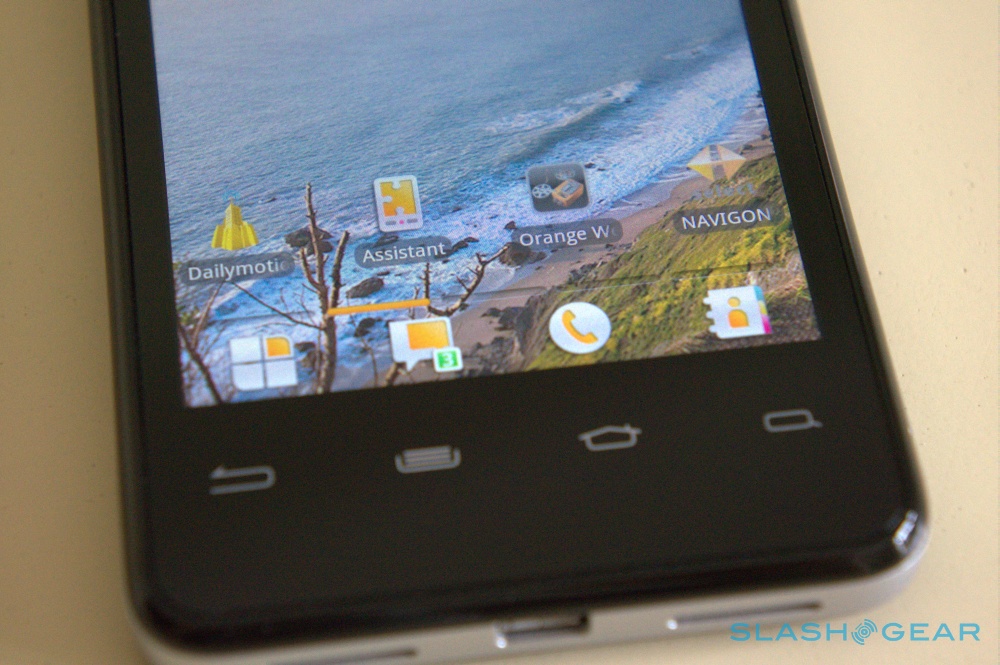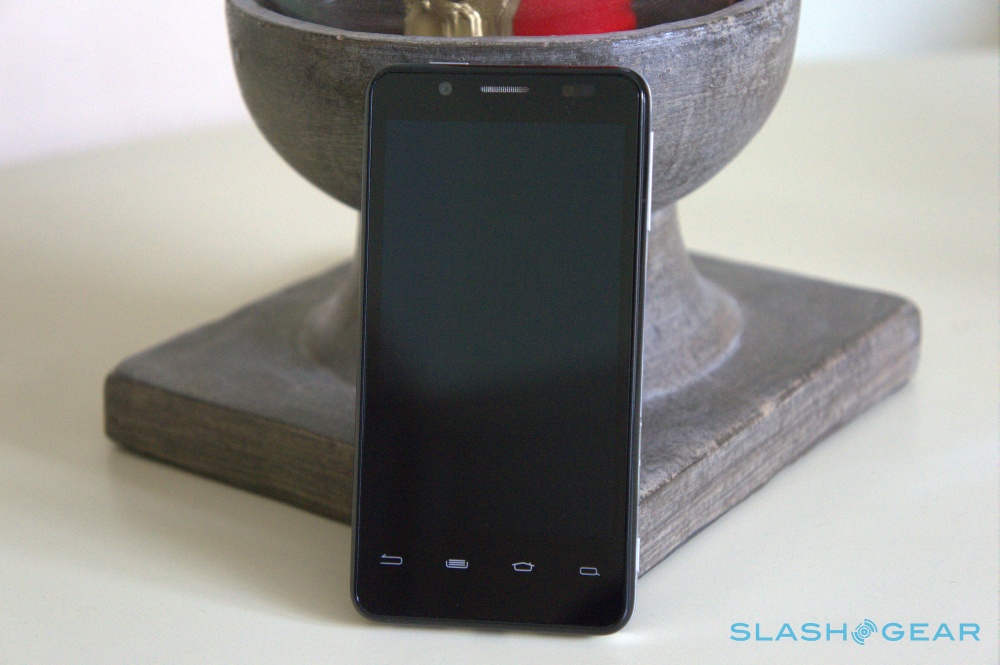Orange San Diego Review
It's taken a long time for Intel's smartphone plans to come to fruition. The company has demoed its processors in mobile devices at several CES events in the past, but has struggled to bring them to market. This year, however, Intel came prepared, announcing a partnership with several manufacturers and carriers that would see Intel's Medfield platform finally making its way into consumers hands. The first phone was the Lava Xolo X900, released in India in May, while the United Kingdom has been graced with the Orange San Diego, previously known as the Santa Clara. So, how does the pairing of Intel and Android hold up? Find out after the jump.
Hardware
The San Diego won't be winning any awards in the design department. It's about as generic a design as you can get, and if you look back at hands-on from CES 2012 you'll actually see that it's a similar design (if not the same) as the reference phone shown off to the press and developers. It's the same black monolithic design you've seen a thousand times before, just with ports and buttons located in different places.
We'll give credit where credit is due: whereas phones at this price point and below often use glossy plastic covers, the San Diego instead opts for a rubberized texture that repels grease and fingerprints. The 4-inch handset is comfortable enough in the hand, even if it is a smidgen too big thanks to the wasted space underneath the four capacitive keys at the bottom of the screen. There's also some noticeable flex to the device. Keep a steady eye on the phone as you shift and twist it in your hands, and you'll hear some creaking emanating from the bottom half, with some noticeable bending to boot. Does it feel like it's going to break? No, and it's solid enough, but it was somewhat alarming at first.
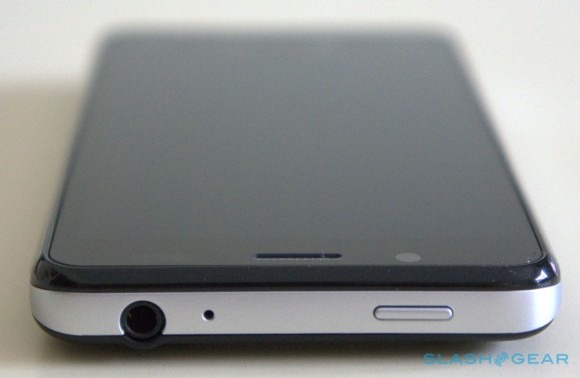
A silver trim goes around the phone which also houses the numerous buttons and ports, including power and the 3.5mm headphone jack at the top, plus volume rocker, camera shutter, and microSIM card slot on the right. A microHDMI output can be found on the left hand side, while microUSB rests on the bottom next to the speaker grills. Odd that Intel didn't spring for a combined port with MHL output, but perhaps the silicon doesn't allow for that yet. The camera shutter didn't present us with any problems, but the power button did give us a bit of trouble at first. It doesn't protrude from the device enough, resulting in not a whole lot of feedback when pressed. It never failed to register our presses, however.
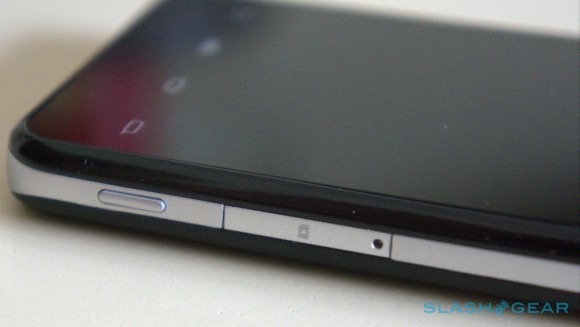
On the back you'll find the eight megapixel camera, a nice surprise considering the £199 price of the handset, although you won't be able to remove the cover. Everything is sealed into the device, including the battery, and there's no options for removable storage. Even worse, USB OTG doesn't seem to work, so you're stuck with the limited internal storage that comes with the device. Orange advertises this as 16GB, although after the operating system and apps take up allocated space, there's about 10.7GB left available to the user.
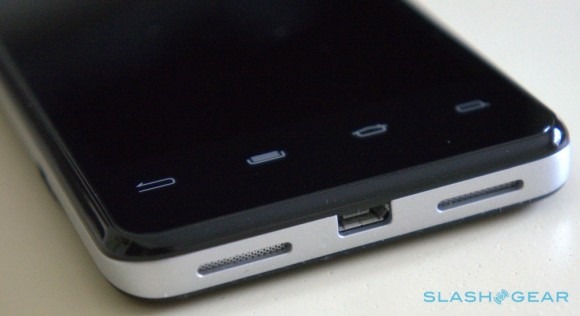
The display on the San Diego is definitely punching above its weight. A resolution of 1024x600 spread across 4-inches of real estate may sound like a strange combination, but it works well. Pixel density is great at 296 PI, but better yet is the quality of the panel. IPS this is most definitely not, but it seems that Intel didn't cut any corners with its manufacturing partner, Gigabyte. Colors are bold and vibrant, viewing angles are above average, and brightness was just about good enough to overcome the glare presented in extreme daylight. Our minor, nitpicky complaints are these: at extreme angles, colours do tend to shift, and holding the phone at an angle while taking a closer look exhibits the same grainess found on the Xperia U. The difference on this handset is that everything looks fantastic when viewed head on, while on the Xperia U it was a constant problem.
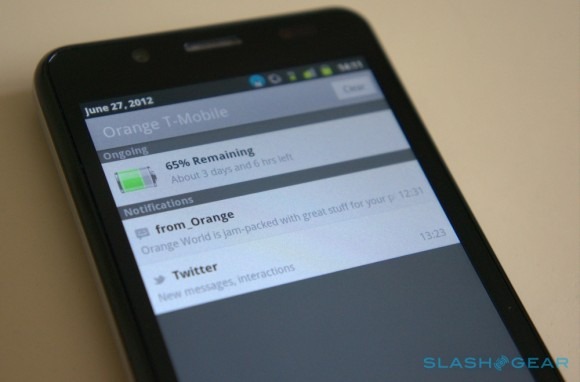
As for all the specs, the San Diego is powered by an Intel Atom Z2460 clocked at 1.6Ghz and paired with 1GB of RAM. Radios include quad-band 3G (850 / 900 / 1900 / 2100) with HSPA+ rated at up to 21Mbit/s. Careful, though: the San Diego is locked to Orange's network, so you won't be able to pick one up and then use it on another network. At the time of writing, there doesn't seem to be an unlocking solution for the phone either. That's a bummer, but you didn't think Orange was going to make it that easy, did you?
Software
We hope you like Gingerbread, because that's what you're going to be stuck with if you buy this phone. It's strange that the phone has been saddled with android 2.3 considering Ice Cream Sandwich has been with us for some time, especially considering the reference Medfield phone was running 4.0 back at CES 2012. Having said that, we imagine the bulk of software testing to bring Atom to Android was done on Gingerbread. Orange say that an Ice Cream Sandwich update is on the cards for Q3, but by then we'll be *another* version higher on the Android software ladder. That's something you'll have to take into consideration.
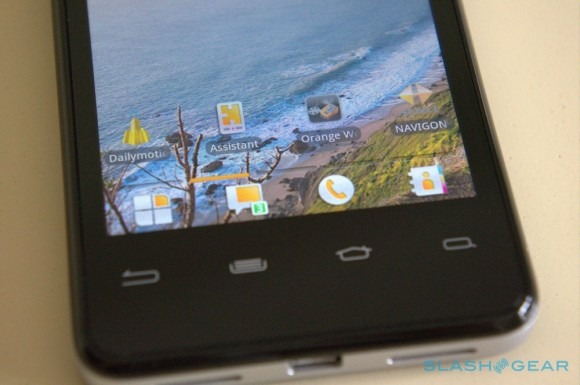
"Well," you say, "I'll just root the device and put whatever I want on there!" Not so fast there, little buddy. Paul O'Brien of MoDaCo fame has confirmed that the phone has a locked bootloader. To make matters worse, he's heard directly from Orange that the carrier has no plans to unlock the phone at all, meaning you won't be able to get root access or flash custom ROMs unless something short of a miracle occurs.
And you know what? That's a shame. Part of the reason for the San Francisco's success was its easy hackability along with the impressive specs for the low price. The San Diego could easily have been a fan favourite among the hacking community, leaving those who wanted custom ROMs free to play around while regular customers still receive the Orange experience. Major players like Samsung and HTC have already recognized the importance of getting the enthusiast community onboard, so why can't Orange and Intel?
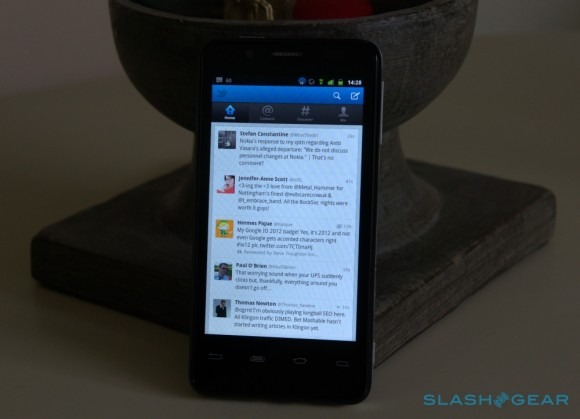
Bootloader ranting aside, Gingerbread is mostly a stock affair but with some minor visual tweaks to the interface made by Orange to fall in line with its other branded phones, such as the San Francisco and Monte Carlo. That primarily comes in the form of the launcher, homescreens, and widgets, although a smattering of apps have also been included with the phone. NAVIGON Select is onboard for turn-by-turn navigation, Quickoffice gives you some basic editing capabilities, doubleTwist provides media playback, and Dailymotion gives you access to online video content. The rest are Orange's own branded apps, including Orange Wednesdays, Tags, Assistant, and Your Orange.
The standout feature that Orange has included is the Gestures application, which lets you draw certain shapes or symbols on the screen to quick launch an application. Let's say you draw an "O" on the screen: the browser springs to life and Orange's homepage loads. Draw a square, and you'll be kicked into the Messaging app, while an arrow opens the Clock. Better yet, you can create custom assignments for drawings, so you're not locked into the defaults, and you can choose just about any shortcut you desire, whether it be launching an app, looking at a contact, or jumping into a Gmail label. We didn't use the feature all that much, but we appreciate having the option and imagine it'll go down a treat with some customers.
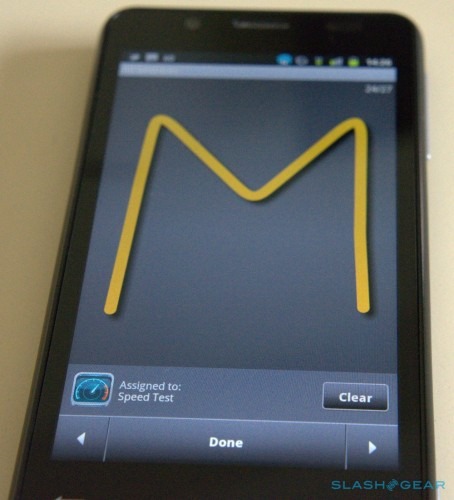
All Android apps are designed to work on ARM processors, but Intel is running everything on x86 thanks to some binary translation trickery. Everything seems to work well, and the majority of apps that we'd normally download to other Android phones ran flawlessly on the San Diego. Having said that, there are some app compatibility issues. Running a quick check against the Top Free apps category will show you exactly what's available and what's missing. The short version is that while most major apps seem to be available for the San Diego, there are notable exceptions like Flash and Temple Run in addition to several other games. One of our favourite video players, Dice Player, was also unavailable.
What about the performance of the handset? Does a single-core Atom with hyperthreading really match up to dual-core offerings from the likes of Samsung, NVIDIA, and Qualcomm? Yes and no. General performance of the phone was a mixed bag, with a laggy launcher that can mostly be blamed on Orange's customizations. Installing a third-party alternative such as LauncherPro yielding much better results. The keyboard was very responsive, and probably performed the best out of all the Gingerbread phones we've used in the past.
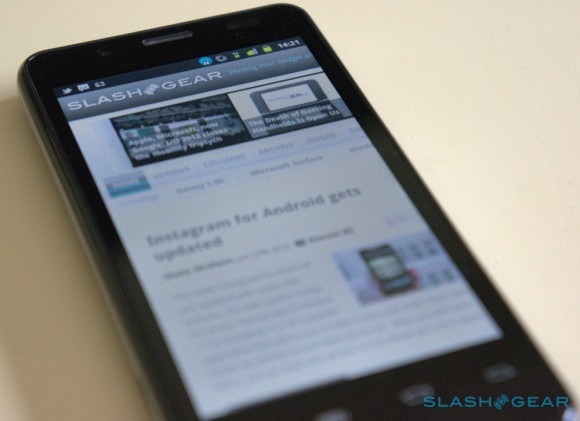
The browser, meanwhile, seemed to always just fall shy of great performance. While pages are quick to load over WiFi and 3G, scrolling is never completely smooth, and it's the same story with pinch-to-zoom. It's about 90% of the way there, but the occasional hiccup and stutter stops everything from being completely perfect. The lack of Ice Cream Sandwich means you won't be able to turn to alternatives like Chrome or Firefox either, and we can't help but wonder if the latest version of Android is all that's holding the phone back from being buttery smooth all around.
In terms of benchmarks, the Atom Z2460 clocked at 1.6Ghz more than held its own. Quadrant returned a score of 3,608, AnTuTu gave us 5,647, NeNaMark 2 finished with 39.7fps, and SunSpider 0.9.1 absolutely screamed with 1,436ms. That's on par with high-end phones like the HTC One X and the Samsung Galaxy S III. Impressive, but we wish it was mirrored in real world browsing tests.
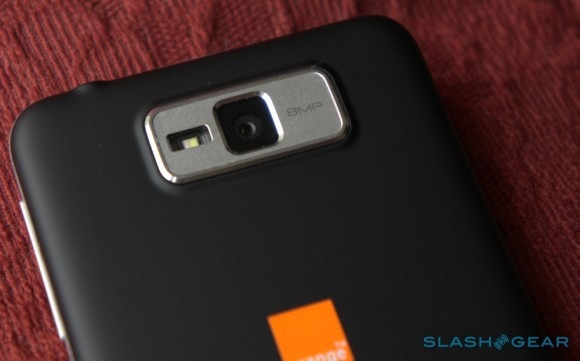
Camera
The eight megapixel sensor serves up decidedly average results, with photos appearing dull and lifeless thanks to undersaturated pictures and a light smattering of noise reduction which is consistently applied. The camera also had trouble focusing on close-up objects, with several attempts needed before the subject would become clear.
As you can see from the flowers in the gallery, reds seem to get some special preference, but not in a good way, looking extremely oversaturated despite the overcast British weather. Noise ramps up considerably in low-light situations too. Burst mode works as advertised, with the phone capturing 10 photos in rapid succession, then allowing the user to pick the best one. It's nice to see such a function making it to a budget phone like the San Diego when the HTC One X and Galaxy S III boast a similar feature, but will you really use it with the camera's dodgy output?
Video recording is a bit of a mess. We hope you enjoy videos that look like they were recorded underwater, because that's pretty much exactly what the 1080p H.264 Baseline L4.1 footage encoded at 15Mbit/s looks like. Cars, motorcycles, and pedestrians devolve into gelatinous forms are they wobble across the screen in the resulting output, with considerable distortion as you pan the phone around. That's made all the more frustrating by the fact the compression is actually pretty good, with no obvious artifacts and only a very minor amount of noise. Sure, the output isn't as sharp as 1080p video you'll find on other smartphones, but most phones in this category are shooting 720p with far worse results. Audio quality is great too, with stereo AAC encoded with a constant bitrate of 320Kbit/s.
Phone and Battery
Call quality was good on the San Diego, with those on the other end coming across without any issues and reporting the same for me. As is often the case, the earpiece could do to be slightly louder, but it's a minor detail.
We weren't unable to perform tests across multiple carriers on the San Diego due to the simlock that Orange has placed on the device. We did reach out to Orange and ask for an unlock code so we could better test the phone, but they were unable to provide one. As a result, we were stuck on Orange and T-Mobile's combined 3G networks and were met with less than impressive results. Speeds never broke the 2Mbit/s barrier no matter where we were throughout London, with tests often falling well below 1Mbit/s matched with occasionally high pings. It's the same story with real world performance, with websites taking longer to load on average when compared against O2 or Three.
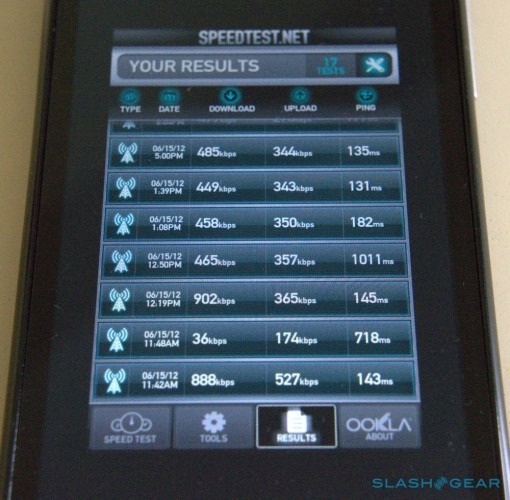
Battery life was a mixed bag, to say the least. Let's get the video rundown out of the way. We took a 1080p H.264 High Profile L4.1 clip with a bitrate of 20Mbit/s and played it on loop, with WiFi/3G left on, brightness set to 100%, and headphones left plugged in with volume set to 50%. The San Diego managed 2 hours and 43 minutes before dying. That's well below what even the most modest devices are capable of achieving, so we re-ran the test with a less demanding 720p H.264 Baseline L3.1 clip with a bitrate of 2Mbit/s, this time managing 3 hours and 59 minutes. That's a tremendous difference, and comes down to the Atom chip's video decoding capabilities. ARM-based chips typically have dedicated video decoders that only have a small difference in power drain depending on the complexity of the video clip, but it looks like it's a pretty huge variance in Intel's case. That's backed up by the temperature of the phone too: the phone was much warmer to the touch after the 1080p test than the 720p, so the Atom chip was definitely feeling the strain despite video playback being perfectly smooth. Even if you take the better of the two results, the battery falls short of other handsets.
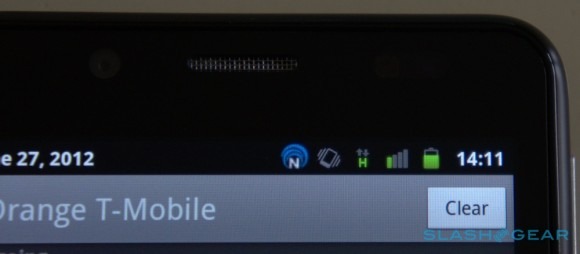
In more typical usage, we could definitely get a full day out of the phone and survive for most of the next too, although the overall drain does seem to be ever so slightly higher than average. Part of the blame can be assigned to the power hungry screen, and during the idle time the phone matched what ARM-based chips had to offer. Web browsing, Twitter updates, push Gmail, and a handful of text messages did see the battery fade away a little quicker than we would have liked, however.
Wrap-Up
Intel deserves some credit. The company has been trying to make x86 work in mobile devices for quite some time, and has finally proven that the whole package is possible with good performance sans ridiculous battery consumption. Now the company needs to start working on refining the process and bringing battery drain up to speed with competitors, because they're certainly not standing still.
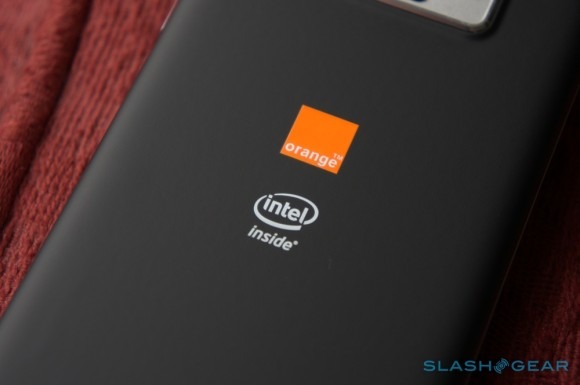
As for the San Diego, it feels more like an experiment or the result of a happy accident that somehow made it into full scale production for general sale. It's a quirky little device that features a good screen and decent longevity, but suffers tremendously from Gingerbread and a mediocre camera. Orange, however, has priced it pretty much perfectly. You'll be paying well above the £199 asking price for phones that rectify those problems, or sacrificing key features and specs if you dip below it. In a nutshell, it's good value for money if you can live with being stuck on an old version of Android for the foreseeable future.














